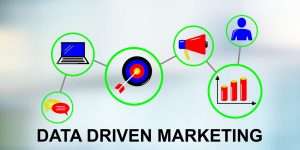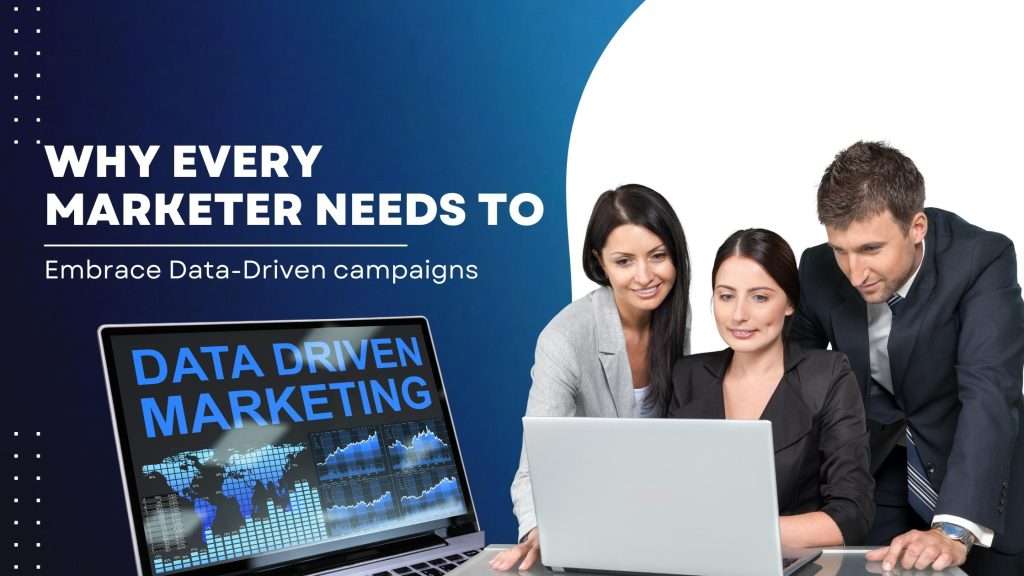Welcome to the era of data-driven marketing! As technology continues to advance at an exponential rate, marketers are finding themselves armed with a wealth of valuable information that can guide their campaigns and drive unprecedented results. Gone are the days of blindly taking shots in the dark, hoping to hit the bullseye. Today, successful marketers understand the power and potential of data-driven campaigns – strategies backed by actionable insights and real-time analytics. In this blog post, we’ll delve into why embracing data is no longer optional for any marketer who wishes to thrive in this ever-evolving digital landscape. So buckle up and get ready to uncover how harnessing the power of data can revolutionize your marketing efforts like never before!
Introduction to Data-Driven Marketing
Data-driven marketing is all about using data to inform your marketing decisions. It’s a holistic approach that takes into account all the data points at your disposal, from customer behavior data to website analytics to sales data. By understanding what your customers are doing and how they’re interacting with your brand, you can make more informed decisions about where to allocate your resources.
Data-driven marketing isn’t just for big businesses either – small businesses can benefit from using data to inform their marketing efforts too. In fact, one of the benefits of data-driven marketing is that it levels the playing field between big and small businesses. With data, you can tailor your marketing campaigns to reach your specific target audience, regardless of your budget or resources.
If you’re not already using data to inform your marketing decisions, now is the time to start. Here are four reasons why every marketer needs to embrace data-driven campaigns:
- Data Gives You Insights Into Customer Behavior
One of the benefits of data-driven marketing is that it gives you insights into customer behavior. By understanding what customers do and how they interact with your brand, you can make more informed decisions about your marketing campaigns. For example, if you see that a particular segment of customers is not responding well to a certain type of campaign, you can adjust your strategy accordingly.
- Data Helps You Optimize Your Marketing Efforts
Another benefit of data-driven marketing is that it helps you optimize your efforts. Data allows you to track the performance of each campaign and measure its success. You can then use this information to tweak and refine your campaigns, so that they reach their maximum potential.
- Data Helps You Reach Your Target Audience
Data-driven marketing also helps you reach your target audience more effectively. By understanding who your customers are and how they interact with your brand, you can create campaigns that are tailored to their interests and preferences. This increases the chances of resonating with them and encourages them to take action.
- Data Can Help You Cut Costs
Finally, data-driven marketing can help you cut costs in the long run. By analyzing customer behavior data, you can make more informed decisions about where to invest your resources—which will help you maximize ROI and minimize unnecessary spending.
Data-driven marketing is an effective way to get the most out of your campaigns. By leveraging data to inform decisions, you can create more effective strategies and reach your target audiences more effectively. With data-driven marketing, you’ll be better equipped to optimize your efforts and make the most out of every dollar you spend.

The Benefits of a Data-Driven Approach
When it comes to marketing, data should be your best friend. A data-driven approach can help you better understand your target audience, what type of content they engage with, and when they’re most likely to convert.
More importantly, a data-driven approach can help you optimize your marketing campaigns in real-time so you can get the most out of your budget and see a higher ROI. Here are just a few of the benefits of using data to drive your marketing campaigns:
- Improved Targeting
With data, you can segment your audience into smaller groups based on shared characteristics like age, location, gender, interests, and more. This allows you to create more targeted campaigns that are more likely to resonate with each individual segment. -
Increased Personalization
Data also allows you to personalize your marketing messages so they feel more relevant to the recipient. In fact, studies have shown that personalized emails are 26% more likely to be opened and 51% more likely to be clicked on. -
Greater Engagement
When done right, data-driven marketing can result in greater engagement from your target audience. This is because you’re able to deliver the right message at the right time through the right channel. As a result, people are more likely to pay attention and act on your call-to-action. -
More Efficient Budgeting
By understanding which channels and campaigns are performing well (and which are not), you can allocate your resources more efficiently and maximize your ROI.
Overall, a data-driven approach to marketing can help you better understand your target audience, increase engagement, personalize messages, and optimize budgets. By using data to drive your marketing strategy, you’ll be able to create campaigns that are more effective and generate better results.
Collecting and Analyzing the Right Data for Your Campaigns
In order to make data-driven decisions for your marketing campaigns, you need to first collect and analyze the right data. This can be a daunting task, but there are a few key things to keep in mind.
First, identify what kind of data is most relevant to your campaign goals. This will vary depending on the type of campaign, but could include things like customer demographics, purchase history, or website behavior. Once you know what data you need, collect it from as many sources as possible.
Next, organize and cleanse your data so that it’s ready for analysis. This step is critical, as even the best data won’t be helpful if it’s not organized properly. Analyze the data to identify patterns and insights that can help guide your campaign decisions.
By following these steps, you can ensure that you’re collecting and analyzing the right data for your campaigns. Doing so will allow you to make more informed decisions that can lead to better results.
Building a Targeted Campaign with Data Insights
As a marketer, you know that data is essential to understanding your customers and crafting targeted campaigns that will resonated with them. But what data should you be using, and how can you turn it into actionable insights?
In this blog post, we’ll share some tips on how to build a targeted campaign using data insights. First, you’ll need to identify the right data to use. This will vary depending on your business and goals, but some examples include customer demographics, purchase history, web browsing behavior, and social media activity.
Once you have your data set, it’s time to start analyzing it. Look for patterns and trends that will give you insights into what your customers want and need. For example, if you see that a certain group of customers always purchases your product after viewing a particular ad or landing page, you know that those elements are working well and should be included in future campaigns targeting that group.
Armed with this data-driven approach, you can create targeted campaigns that are more likely to resonate with your audience and drive conversions. So don’t wait – start leveraging data today to improve your marketing results!
Data-Driven marketing Strategies for Turning Big Data into Actionable Insights
As a marketer, you’re likely well aware of the power of data-driven campaigns. After all, what could be more effective than basing your marketing efforts on hard evidence of what works and what doesn’t?
However, simply collecting data is not enough – you also need to know how to turn it into actionable insights. Otherwise, you’re just wasting time and resources.
So, how can you turn big data into actionable insights? Here are a few strategies to get you started:
- Define your goals and KPIs upfront
Before you start collecting data, it’s important to have a clear idea of what you want to achieve with your data-driven campaign. What are your goals? What KPIs will you use to measure success? Once you know the answers to these questions, you can start collecting the right data to help you reach your goals.
- Use the right tools for analysis
There are a variety of different tools available for analyzing big data. Choose the ones that are best suited for your specific needs and objectives. Some popular options include Google Analytics, Tableau, and R.
- Create easy-to-understand visualizations
Once you’ve analyzed your data, it’s time to start turning it into something that’s easy for others to understand. After all, what good is all this data if no one can make sense of it? That’s where data visualization tools come in handy. They allow you to quickly create charts, graphs, and other visual representations of your data that are easy to interpret.
- Monitor trends and take advantage of them
Data should not be a static entity – it is constantly changing and evolving. As such, it’s important to stay on top of the latest trends and use them to inform your decision-making. For example, if you notice that a particular audience segment is responding well to certain types of content or ads, you can adjust your strategy accordingly.
- Test different strategies and measure results
Finally, don’t be afraid to experiment with different strategies based on your data insights. This will help you find out what works best for your audience and enable you to refine your approach over time. And remember – always measure the results of your tests so that you can keep improving!
Measuring the Success of Your Data-Driven marketing Campaigns with Analytics
In order to accurately gauge the success of your marketing campaigns, you need to have a solid understanding of analytics. Analytics can help you track how many people are seeing your content, how long they’re engaging with it, and whether or not they’re taking the desired action (such as making a purchase).
There are a number of different analytics tools available, but Google Analytics is one of the most popular and user-friendly options. Once you’ve set up an account and installed the tracking code on your website, you can start tracking your campaign data.
To measure the success of your campaigns, start by looking at your overall traffic numbers. Then, take a look at specific campaign metrics, such as click-through rates and conversion rates. You can also use analytics to segment your audience and see which groups are most responsive to your campaigns.
By using analytics to track your campaign performance, you can make data-driven decisions that will help you improve your results over time.
Conclusion
Data-driven campaigns are becoming increasingly important in marketing, and it’s essential for marketers to embrace them. By using data-driven strategies and tactics, marketers can measure their performance more accurately with real-time insights into how their campaigns are performing. This allows them to adjust quickly and make more informed decisions that will improve customer experience as well as ROI. With the right data tools in place, every marketer should be able to leverage the power of data-driven campaigns to drive better results for their business.

